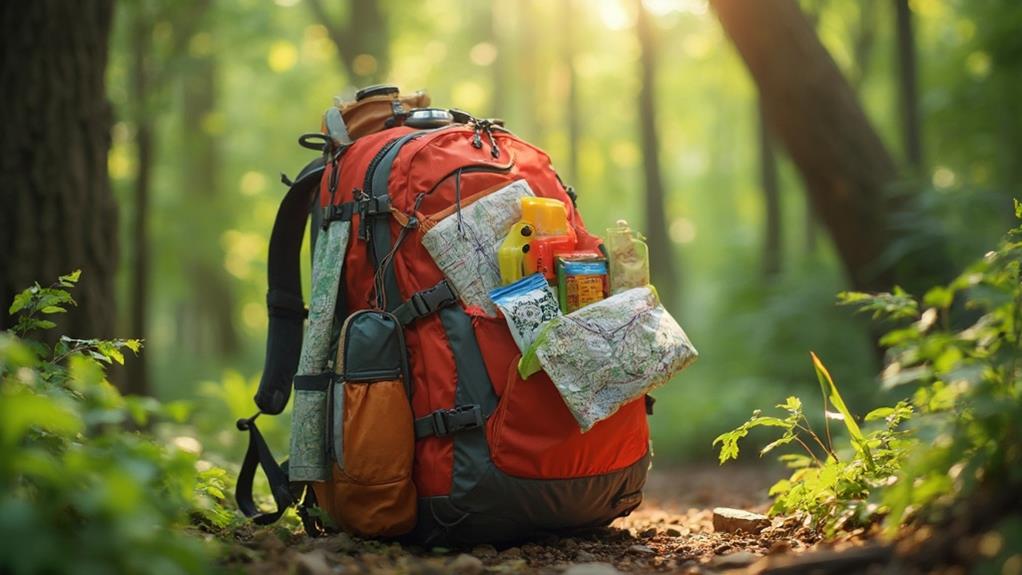Preparing for your first day hike starts with choosing a manageable trail under 5 miles with little elevation gain. Utilize tools like AllTrails to research and verify it's suitable for beginners. Packing essentials is vital; bring enough water, high-energy snacks, a first aid kit, and navigation tools. Learn basic navigation skills, including reading maps and recognizing trail markers. Prioritize safety by informing someone of your plans and carrying emergency supplies. Finally, respect trail etiquette, like yielding to uphill hikers and maintaining a quiet presence. Embrace these strategies to enhance your hiking experience and pave the way for further insights.
Key Takeaways
- Choose trails under 5 miles with minimal elevation gain for a beginner-friendly hike.
- Pack at least 2 liters of water and high-energy snacks for hydration and energy.
- Wear moisture-wicking clothing and sturdy footwear to prevent discomfort and injury.
- Inform someone of your hiking plans, route, and expected return for safety.
- Respect trail etiquette by yielding to uphill hikers and keeping noise minimal.
Choose the Right Trail
When initiating your first day hike, selecting a suitable trail is paramount to guaranteeing an enjoyable and safe experience.
Trail selection, particularly for beginners, requires thoughtful consideration of various factors to match your fitness level and hiking proficiency. Start by researching trails that are under 5 miles in length with minimal elevation gain. This will provide a manageable and less physically demanding experience, allowing you to focus on enjoying the surroundings rather than straining through difficult terrain.
Utilize reliable resources such as AllTrails and GaiaGPS, which offer extensive databases of trail reviews and information tailored to beginner considerations. These platforms can help you identify well-marked and popular trails, typically providing greater safety and security for novice hikers.
Additionally, be aware of any permit requirements and regulations specific to the trail, as compliance is necessary for accessing certain areas.
Consider the time of year and current weather conditions; these can heavily influence trail accessibility and safety. Opting for trails during favorable weather conditions minimizes risks and enhances your hiking experience.
Pack Essential Gear

Packing essential gear is the cornerstone of a successful and enjoyable day hike. To guarantee a seamless experience, prioritize your hydration strategies by packing at least 2 liters of water. This baseline amount should be adjusted according to the hike's distance and weather conditions, making sure you remain hydrated in varying environments.
Alongside water, consider bringing high-energy snack options like nuts, energy bars, and dried fruit. These snacks provide the necessary sustenance to maintain your energy levels throughout the hike, offering quick and convenient nutritional boosts.
Equally important is a lightweight first aid kit, which should include essentials such as adhesive bandages, antiseptic wipes, and pain relievers. This kit is crucial for addressing minor injuries and ensuring your safety on the trail.
Additionally, wear moisture-wicking clothing and sturdy, supportive footwear specifically designed for hiking. This attire prevents discomfort and reduces the risk of injury, enhancing your overall hiking experience.
Lastly, while navigation tools will be discussed later, it's prudent to have a map or trail app ready. A fully charged phone is also significant for emergencies, keeping you connected and safe.
Proper gear guarantees that your first day hike is both enjoyable and safe.
Understand Navigation Basics
Finding your way along the trail is as fundamental to a successful day hike as packing the right gear. Mastering map reading and compass skills is essential. Start by familiarizing yourself with basic map reading, focusing on contour lines and symbols representing trails, water sources, and landmarks. These skills are not merely academic; they are practical tools enhancing your confidence and decision-making on the trail. Always carry a physical map of the hiking area, serving as a reliable backup in areas where cell service is weak or non-existent.
| Navigation Tool | Purpose |
|---|---|
| Physical Map | Reliable backup for guidance |
| Compass | Orienting and steering with the map |
| Offline Maps | Backup guidance without draining battery |
| Trail Markers | Visual cues for direction and orientation |
| Landmarks | Key points for confirming location |
Incorporate a compass with your map for efficient guidance. Learning to align your map with a compass helps maintain your course. Additionally, downloading offline maps on your smartphone or GPS device guarantees you have access to navigation tools without draining your battery. Finally, practice recognizing key landmarks and trail markers along your route. This enhances your ability to steer intuitively and confidently, guaranteeing your day hike is both safe and enjoyable.
Prioritize Safety Measures

Starting on a day hike requires careful thought of safety measures to guarantee a secure and enjoyable experience. One of the first steps is to inform a friend or family member about your hiking plans, including your route and expected return time. This makes sure that someone is aware of your whereabouts and can initiate emergency communication if necessary.
Carrying a basic first aid kit is essential for addressing minor injuries. This kit should include adhesive bandages, antiseptic wipes, and pain relievers.
Familiarizing yourself with potential trail hazards is vital for effective wildlife awareness and avoiding dangerous situations. Here are some additional safety measures to take into account:
- Emergency Equipment: Always have a whistle and an emergency blanket in your pack. These items are critical for signaling for help and providing warmth if unexpected situations arise.
- Communication Devices: Keep a fully charged cell phone on hand, but also think about a GPS device or a map and compass as backups, particularly in areas with limited reception.
- Trail Awareness: Understand the terrain and be vigilant about unstable ground and wildlife encounters.
- Continuous Updates: Regularly update your contact person if your plans change, making sure they have the latest information.
Implementing these safety measures will enhance both your preparedness and confidence during your hike.
Respect Trail Etiquette
While guaranteeing safety is paramount on a day hike, equally important is the practice of respecting trail etiquette to enhance the experience for yourself and others. Observing proper trail etiquette not only fosters a sense of community but also guarantees the preservation of the natural environment.
One fundamental rule to remember is that uphill hikers have the right of way. Yielding hikers should step aside to allow those ascending to continue their journey without interruption, guaranteeing a smooth flow of movement on the trail.
Engage in friendly greetings with fellow hikers as you pass each other. This simple gesture promotes a welcoming atmosphere and encourages camaraderie among outdoor enthusiasts.
Keeping your voice at a low volume is essential to maintain the serenity of the surroundings and respect the experience of those around you. When listening to music, use headphones to prevent disturbance, allowing everyone to enjoy the natural sounds.
Additionally, responsible pet ownership is vital. Always keep dogs leashed and under control to safeguard wildlife and other hikers, minimizing potential disturbances.
Frequently Asked Questions
How Do I Prepare for Days Before Hiking?
To prepare for hiking, guarantee your gear checklist is complete, including essentials like water, snacks, and a first-aid kit. Familiarize yourself with trail etiquette to respect nature and other hikers, enhancing your overall experience.
What Do You Need for Your First Hike?
For your first hike, essential gear includes a hydration system, snacks, a first-aid kit, and weather-appropriate clothing. Prioritize safety by wearing proper footwear, carrying navigation tools, and informing someone of your route and expected return time.
How to Get in Shape for a Hike?
To get in shape for a hike, integrate regular cardiovascular and strength training exercises into your routine. Emphasize hydration strategies and familiarize yourself with hiking gear to guarantee physical readiness and comfort on the trail.
How Do I Prepare for a 2 Day Hike?
To prepare for a two-day hike, focus on thorough gear selection, ensuring essentials like a reliable tent and weather-appropriate clothing. Master trail navigation by studying maps and understanding the route, enhancing both safety and enjoyment during your adventure.
Conclusion
Starting on a first day hike requires meticulous preparation to guarantee a safe and enjoyable experience. Selecting an appropriate trail sets the foundation for success, while packing essential gear guarantees readiness for various conditions. Mastering fundamental navigation skills further enhances confidence and security. Safety measures must be prioritized to mitigate risks, and adherence to trail etiquette fosters a respectful and harmonious environment for all hikers. By following these guidelines, one can start on a rewarding and memorable hiking adventure.